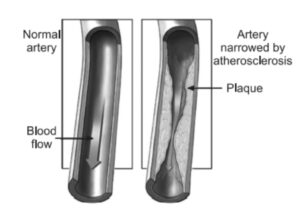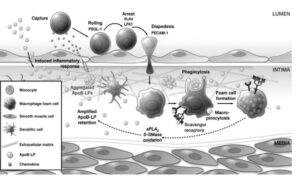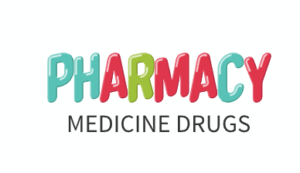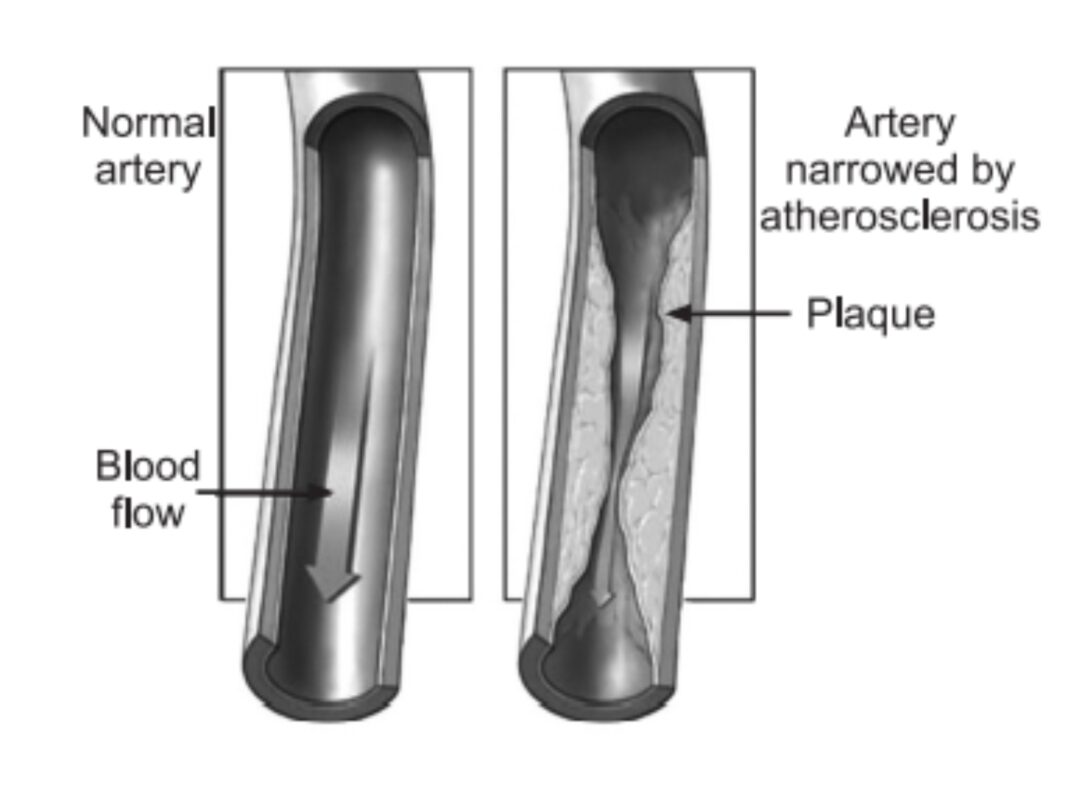Atherosclerosis Pronunciation | What Exactly is Atherosclerosis?
Atherosclerosis (or arteriosclerotic vascular disease) is a condition where the arteries become narrowed and hardened due to an excessive buildup of plaque around the artery wall. Plaque is made up of fat, cholesterol, calcium, and other substances found in the blood. Over time, plaque hardens and narrows arteries. The disease disrupts the flow of blood around the body, posing serious cardiovascular complications. Atherosclerosis can lead to serious problems, including heart attack, stroke, or even death. Healthy arteries are flexible and elastic, but over time, the walls in arteries can harden, a condition commonly called hardening of the arteries. The word atherosclerosis is of Greek origin and
literally means focal accumulation of lipid and thickening of arterial intima (sclerosis
[hardening]). Atherosclerosis can affect any artery in the body, including arteries in the heart, brain, arms, legs, pelvis and kidneys. As a result, different diseases may develop based on which arteries are affected. Arteriosclerosis is the stiffening or hardening of the artery walls. Atherosclerosis is the narrowing of the artery because of plaque build-up.
All patients with atherosclerosis have arteriosclerosis, but those with arteriosclerosis might not necessarily have atherosclerosis. However, the two terms are frequently used with the same meaning.

Causes of Atherosclerosis | Morphology of atherosclerosis
Atherosclerosis can begin in the late teens, but it usually takes decades to cause
symptoms. Some people experience rapidly progressing atherosclerosis during their thirties, other during their fifties or sixties. Certain factors that can damage the inner area of the artery (endothelium) and can trigger atherosclerosis include:
- High blood pressure
- High levels of cholesterol
- Smoking
- High levels of sugar in the blood
Areas of the artery that are damaged are likely to have plaque buildup which can eventually break open. When the plaque breaks open, blood cell fragments called
thrombocytes (or platelets) accumulate at the affected area. These fragments can then
stick together, forming blood clots. High triglycerides: Most fat in food and in the body takes the form of triglycerides. Blood triglyceride levels above 400 mg/dL have been linked to coronary artery disease in some people. Triglycerides, however, are not nearly as harmful as LDL cholesterol.
- Diabetes: Patients with poorly controlled diabetes, who frequently have excess blood glucose levels, are much more likely to develop atherosclerosis.
- Genetics: People with a parent or sibling who has/had atherosclerosis and cardiovascular disease have a much higher risk of developing atherosclerosis than
others. - Obesity: Excess weight increases the strain on the heart and increases the risk of developing atherosclerosis even if no other risk factors are present.

Pathophysiology Of Atherosclerosis | ppt
Very low density lipoprotein (VLDL) is produced by the liver and is changed into LDL by means of lipoprotein lipase. This process removes triglycerides from VLDL by hydrolysis, releasing fatty acids and leaving greater numbers of cholesterol, thus increasing the density of the molecule. The LDL crosses the endothelium and moves into the extracellular matrix where it is oxidized (by the aforementioned steps above), and forms oxidized LDL (OxLDL). OxLDL is a cause of inflammation and signals monocytes (white blood cells) to
enter the arterial wall to fix the inflammation. As monocytes enter the arterial wall, they transform into macrophages. Since the LDL is now oxidized due to aldehydes and lipid hydroperoxides, the modified apolipoprotein B in LDL attaches to macrophage scavenger receptor cells. At this stage, OxLDL has a very high number of cholesterol and cholesterol esters, since it lost antioxidants, triglycerides, and fatty acids in previous steps. Macrophages are supposed to remove cholesterol by use of high density lipoprotein (HDL) particles, but if there is too much excess cholesterol, it causes the macrophages to enlarge and fill with lipids. Eventually the macrophages build up and convert into lipid-laden foam cells (a collection of fatty materials and cholesterol) which die and become part of the plaque that causes atherosclerosis. As this process continues, more and more LDL becomes trapped within the tunica intima (the innermost layer of the arterial wall) creating a pool of cholesterol called a fatty streak. The smooth muscle cells move from the tunica media (the thickest layer of the artery) to the tunica intima and become proliferated by way of released cytokines (proteins that help with immunity) within the macrophages. The major atherosclerosis causing plaque has a fibrous cap, which sticks out into the artery, causing
vasoconstriction, and blocking blood flow (the plaque always forms in the lumen,
which is between the intima and the musculature of the wall.
Related:Wound Healing | Stages And Phases Of Wound Healing PPT
Inflammation Definition | Types Of Inflammation | Etiology | Cardinal Signs
Symptoms Of Pathophysiology | Atherosclerosis Symptoms
Atherosclerosis does not usually produce symptoms until blood circulation becomes restricted or blocked, leading to cardiovascular disease (CVD). The type of cardiovascular disease and its associated symptoms depends on, where the blockage occurs. The first signs of atherosclerosis can begin to develop during adolescence, with streaks of white blood cells appearing on the artery wall. The symptoms of the disease depend on, which arteries are affected.
Carotid Arteries: These arteries provide blood to the brain. When the blood supply is limited, patients can suffer stroke and may experience:
- Weakness
- Difficulty in breathing
- Headache
- Facial numbness
- Paralysis
Coronary Arteries: These arteries provide blood to the heart, when the blood supply to the heart is limited, it can cause angina and heart attack. Symptoms include:
- Vomiting
- Extreme anxiety
- Chest pain
- Coughing
- Feeling faint
Heart attack: If one of the plaques in coronary arteries ruptures, it could create a blood clot. If the blood clot blocks the supply of blood to heart, it will cause to have a heart attack. Symptoms of a heart attack include:
- Chest pain – usually located in the centre of chest and giving the sensation
of pressure, tightness or squeezing. - Pain in other parts of the body that can feel as though it is travelling from chest
to arms. (usually the left arm, although both arms can be affected), jaw, neck, back and abdomen. - An overwhelming sense of anxiety.
- Shortness of breath, feeling sick, lightheadedness, coughing, vomiting, wheezing.
Aneurysm: If atherosclerosis weakens the walls of blood vessels, it can lead to the formation of an aneurysm (a bulge in a blood vessel).
If the aneurysm grows too large, there is a danger. It will rupture, which can cause potentially fatal internal bleeding and organ damage. An aneurysm can develop anywhere in the body, but the two most common types of aneurysm are:
- A brain aneurysm (also known as a cerebral aneurysm), which develops inside the brain.
- An aortic aneurysm, which develops inside the aorta (a large blood vessel
that runs down the abdomen and transports blood away from heart). If an aortic aneurysm ruptures, the person will experience a sudden and severe pain in the middle or side abdomen. In men, the pain can spread down into the scrotum (the sac containing the testicles). Symptoms of a ruptured brain aneurysm usually begin with a sudden and severe headache, which has been described as like being hit on the head.
Renal arteries: These supply blood to the kidneys; if the blood supply becomes limited, there is a serious risk of developing chronic renal failure, and the patient may experience:
- Loss of appetite.
- Swelling of the hands and feet.
- Difficulty in concentrating
Peripheral arterial disease: The arteries to the limbs, usually the legs, are blocked.
The most common symptom is leg pain, either in one or both legs, usually in the calves, thighs or hips. The pain may be described as one of heaviness, cramp, or dullness in the leg muscles. Other symptoms may include:
- Hair loss on legs or feet
- Male impotence (erectile dysfunction)
- Numbness in the legs
- The colour of the skin on the legs change
- The toenails get thicker
- Weakness in the legs
Atherosclerosis | |
|---|---|
| In the coronary (heart) arteries | Chest pain, heart attack, or sudden death |
| In the coarotid (brain) arteries | weakness, loss of speech, or blindness |
| In the fermoral (leg) arteries | Diseases of the blood vessels in the outer parts of the body (peripheral vascular disease) causer-scramping and fatigue in the caluves when walking. |
| In the renal (kidney) arteries, in the arteries leading to genitals | High blood pressure that is difficult to treat, pain during sex. Sometimes, atherosclerosis can cause eractile dysfunction in men. In women, high blood pressure can reduce blood flow to the vagina, making sex less pleasurable |

